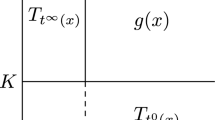Abstract
The previous theorem of the author on the analytic structure of the bubble diagram functions that occur in unitary equations (and are kernels of products of connected scattering operatorsS c m,n or (S −1) c m,n , and related quantities), is extended to a class of situations, called here in generalu=0 points, that were not covered by this earlier result.
This new theorem, which is proved on the basis of a refined macrocausality condition, resolves one of the remaining crucial problems in the derivation of discontinuity formulae and related results inS-matrix theory: all points are in factu=0 points for some of the bubble diagram functions, such as ≡⊕≡⊖≡ (≡(S −1) c3,3 S c3,3 ), that are encountered even in the simplest cases. In all previous approaches, ad hoc technical assumptions with no a priori physical basis were required for these terms.
The origin of theu=0 problem is the absence of information, in general, on a product of distributions that are boundary values of analytic functions from opposite directions, and more generally on the essential support, or singular spectrum, of a product of distributions whose essential supports contain opposite directions. On the other hand, the recent results obtained by Kashiwara-Kawai-Stapp in the framework of hyperfunction theory apply mainly to phase-space factors, whose bubbles are constants times conservation δ-functions rather than actual scattering operators. The present work has basically required the development of new physical and mathematical ideas and methods. In particular, a new general result on the essential support of a product of bounded operators is presented inu=0 situations, under a general regularity property on individual terms. The latter follows in the application from the refined macrocausality condition, in the same time as information on the essential support ofS-matrix kernels.
Similar content being viewed by others
References
For a general presentation of various aspects of the subject, including new results and references, see: Stapp, H.P.: Discontinuity formulas for multiparticle amplitudes. In: Structural analysis of collision amplitudes (eds. R. Balian, D. Iagolnitzer), p. 191. Amsterdam: North-Holland 1976
Iagolnitzer, D.: TheS-matrix, Chap. III. Amsterdam: North-Holland 1978
Iagolnitzer, D.: Macrocausality, unitarity and discontinuity formulae inS-matrix theory. Publ. RIMS, Kyoto Univ.12, Suppl. 89–112 (1977)
Stapp, H.P.: J. Math. Phys.9, 1548 (1968); Coster, J., Stapp, H.P.: J. Math. Phys.10, 371 (1969);11, 1441 (1970);11, 2743 (1970);16, 1288 (1975)
Bloxham, M.I.W., Olive, D.I., Polkinghorne, J.C.: J. Math. Phys.10, 494 (1969);10, 545 (1969);10, 553 (1969) See also earlier results in: Eden, R.J., Landshoff, P.-V., Olive, D.I., Polkinghorne, J.C.: The analyticS-matrix, Chap. 4. Cambridge: Cambridge University Press 1966
Essential support theory (in the analytic sense which is the one of interest here) was developed in the seventies in various directions by a collaboration of the present author and J. Bros; concerning the basic notions and results of interest in the present work, see [5,7] below, and for more details: Iagolnitzer, D.: Analytic structure of distributions and essential support theory. In: Structural analysis of collision amplitudes (eds. R. Balian, D. Iagolnitzer), p. 295. Amsterdam: North-Holland 1976
Iagolnitzer, D.: Introduction toS-matrix theory, Chap. II. Paris: ADT 1973; or Chapt. II in the new version of this book; see [1b]
Iagolnitzer, D., Stapp, H.P.: Commun. math. Phys.14, 15 (1969). This work makes use of, and develops, ideas and results of earlier works and more particularly of: Chandler, C., Stapp, H.P.: J. Math. Phys.90, 826 (1969), first issued in a preprint form in 1967, and Omnès, R.: Phys. Rev.146, 1123 (1966)
Iagolnitzer, D.: Saclay report (1974) and Commun. math. Phys.41, 39 (1975)
Iagolnizer, D., Stapp, M.P.: The pole-factorization theorem inS-matrix theory. Commun. math. Phys.57, 1 (1977)
Iagolnitzer, D.: See [1b]
Simple examples of such points will be found for instance in: TheS-matrix, Chap. II, in [1b]. Different examples have been given earlier in: Chandler, C.: Helv. Phys. Acta42, 759 (1969)
Kawai, T., Stapp, H.P.: Proceedings of International Conference on Mathematical Physics, Kyoto, 1975. In: Lecture notes in physics, Vol. 39, p. 36. Berlin, Heidelberg, New York: Springer 1975
Kawai, T., Stapp, H.P.: Discontinuity formula and Sato's conjecture. Publ. RIMS, Kyoto Univ.12, Suppl., 155–232 (1977)
Sato, M., Kawai, T., Kashiwara, M.: Microfunctions and pseudo-differential equations. In: Hyperfunctions and pseudo-differential equations. Lecture notes in mathematics, Vol. 287, p. 265. Berlin, Heidelberg, New York: Springer 1973
Iagolnitzer, D.: Microlocal essential support of a distribution and decomposition theorems. In: Hyperfunctions and theoretical physics (ed. F. Pham), p. 121. Berlin, Heidelberg, New York: Springer 1975; Bony, J.: Equivalence des diverses notions de spectre singulier analytiques. Sem. Goulaouic-Schwartz 1976/77, Ecole Polytechnique, Paris, Exposé III
Kashiwara, M., Kawai, T., Stapp, H.P.: Microanalytic structure of theS-matrix and related functions. Publ. RIMS, Kyoto Univ.12, Suppl., 141–146 (1977)
detailed version of the previous text (in preparation)
Kashiwara, M., Kawaï, T.: On holonomic systems for\(\sum\limits_{l = 1}^N {(f_l + i0)^{\lambda _I } } \). Princeton Preprint (1978)
Iagolnitzer, D.: Unpublished (1975). An improved version of the structure theorem of [7], based on the extension of macrocausality toM 0 points, was first proposed in [11]. However, the definitions and results given there are not adequate
See Appendix A in: Coster, J., Stapp, H.P.: J. Math. Phys.11, 2743 (1970)
Iagolnitzer, D.: TheS-matrix, Chap. I, see [1b]
Williams, D.N.: J. Math. Phys.8, 1807 (1967)
Stapp, H.P.: See [1,2]
These functions, which are a relativistic adaptation of functions previously defined in the non-relativistic case in: Wigner, E.P.: Phys. Rev.40, 479 (1932), have been introduced and studied in detail in: Iagolnitzer, D.: Thesis, Paris (1967) and J. Math. Phys.10, 1241 (1969) See also, Stapp, H.P.: Foundations ofS-matrix theory. Berkeley Report (1973) and Iagolnitzer, D.: TheS-matrix, Chap. I (see [1b])
See Iagolnitzer, D.: Space-time properties and physical region analyticity anS-matrix theory. In: Lectures in theoretical physics (ed. K. T. Mahanthappa, W. E. Brittin). New York: Gordon and Breach 1969
Stapp, H.P.: Private communication
Author information
Authors and Affiliations
Additional information
Communicated by R. Stora
Rights and permissions
About this article
Cite this article
Iagolnitzer, D. Theu=0 structure theorem. Commun.Math. Phys. 63, 49–96 (1978). https://doi.org/10.1007/BF02156129
Received:
Revised:
Issue Date:
DOI: https://doi.org/10.1007/BF02156129



